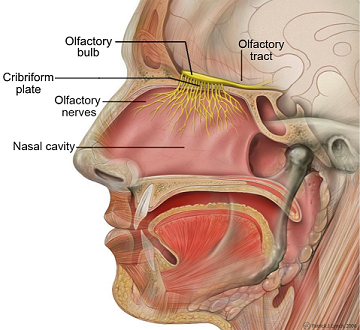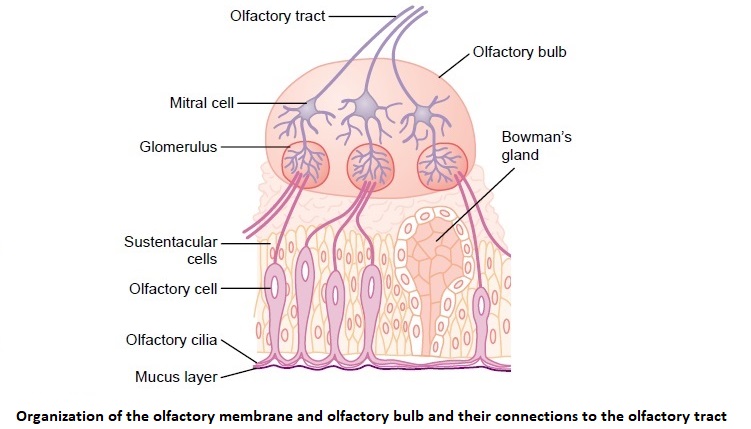
- Olfaction is the sense of smell. It is how we perceive odors.
- Nose is the organ with millions of olfactory receptors that help us perceive odor or smell.
- Our sense of smell is believed to be about 20,000 times more sensitive than our sense of taste.
Also see: Structure of Taste receptors and Mechanism of Gustation
- We can taste quinine in a concentration of 1 part in 2 million, but we can smell mercaptans (the type of chemical released by skunks, old world relatives of stink badgers) in a concentration of 1 part in 30 billion.
- Adults can usually sense up to 10,000 different odors, and children can do even better.
- Unfortunately, our sense of smell is not perfect as we cannot detect several poisonous gases including carbon monoxide.
Structure of Olfactory receptors:
- The olfactory receptor cells are located high in the roof of the nasal cavity, in specialized areas of the nasal mucosa, called the olfactory epithelium.
- Each nostril contains a small patch of olfactory epithelium of about 2.5 sq. cm that bears pseudo-stratified and columnar epithelial cells.
- This olfactory epithelium consists of three types of cells;
1. Receptor cells:
- Receptor cells or chemo-receptor cells actually are the olfactory neurons.
- Each receptor cell is thin and has a short dendrite extending from its superficial end to the surface epithelium.
- These olfactory neurons have a lifetime of about 30 days.
- We have about 25 million bipolar receptor cells (a hunting dog has about 220 million).
- Receptor cells are surrounded by sustentacular cells and end in a bulbous olfactory vesicle. 6 to 20 long cilia project from the olfactory vesicle and through the mucus-like fluid that covers the surface epithelium.
- The fluid is secreted by the sustentacular cells and olfactory glands called Bowman’s glands.

https://www.brainkart.com/article/Stimulation-of-the-Olfactory-Cells—Sense-of-Smell_19711/
- Mucus is important because odoriferous substances need to be dissolved before they can stimulate receptor sites.
- The receptive sites of the cilia are exposed to the molecules responsible for odors. The axons of the bipolar receptor cells pass through the basal lamina and join other axons to form fascicles of the olfactory nerve (Cranial nerve I). These unmyelinated olfactory nerve fibers are among the smallest and slowest-conducting fibers of the nervous system.
- They pass through the foramina in the cribriform plate of the ethmoid bone on their way to the olfactory bulb.
- The olfactory bulbs are specialized structures of gray matter, stem-like extensions of the olfactory region of the brain. They consist of three major types of cells;
- Tufted cells
- Granule cells
- Mitral cells
- Once inside the olfactory bulbs, the terminal axons of the receptor cells synapse with dendrites of tufted cells, granule cells and mitral cells. These complex ball-like synapses are called olfactory glomeruli.
- Each glomerulus receives impulses from about 26,000 receptor cell axons. These impulses are conveyed along the axons of mitral and tufted cells, which form the olfactory tract running posteriorly to the olfactory cortex in the temporal lobe of the cerebrum.
- Olfaction is the only sense that does not project fibers into the thalamus before reaching the cerebral cortex.
2. Sustentacular cells:
- They are the supporting cells and surround the receptor cells.
- They function as metabolic and physical support for the olfactory epithelium.
- Some of them have been found to be involved in the phagocytosis of dead neurons.
3. Basal cells:
- These cells form a thin layer and are capable of undergoing cell division and replacing degenerating receptor and sustentacular cells.
- They also form new synaptic connections in the olfactory bulb.
Mechanism of olfaction (How odors are perceived?):
- In order for the substances to be sensed, they must be volatile and soluble.
- Without these qualities, the odoriferous particles could not be carried into the nostrils by air currents, dissolve in the mucus-like coating on the olfactory epithelium, and penetrate the lipid barrier surrounding the olfactory receptor cell.
- Olfactory impulses are sorted and integrated in the glomeruli before being relayed to the cortex.
- It is believed that the glomeruli are the critical sites where odors are first processed. The olfactory cortex is initially involved in the distinguishing and determining the intensities of odors.
- A likely suggestion among many theories regarding neural mechanism of olfaction is that odor molecules have a physical interaction with protein receptor sites on a plasma membrane.
- This binding opens ion channels, allowing sodium ions to flow into the interior of the cell and depolarize it, causing a generator potential.
- The generator potential produces action potentials in the nerve fibers that synapse with neurons in the olfactory bulb.
- According to this theory, the discrimination of different odors results from the simultaneous but varying stimulation of receptor cells.
Neural pathways for Olfaction:
- Mitral cells in the olfactory bulbs project axonal branches through the olfactory tract to the primary olfactory cortex.
- The primary olfactory cortex is composed of the cortex in the uncus (an anterior extremity of the parahippocampal gyrus) and adjacent areas, located in the temporal lobe of the cerebral cortex.